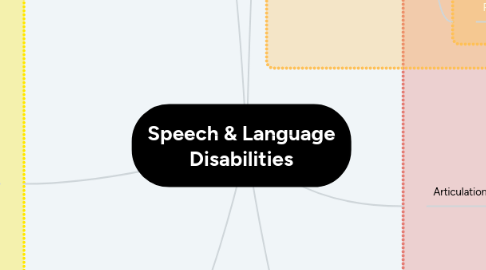
1. Fluency
1.1. Key terms/define
1.1.1. Disruption of the flow of speech, often by repetition, prolonging, or avoiding certain words. A child with this type of speech impairment may hesitate, stutter, or have blocks of silence when speaking
1.1.2. Types of stuttering
1.1.2.1. Blocks
1.1.2.1.1. Blocks of airflow or voicing during speech.
1.1.3. Repetition
1.1.3.1. When a child repeats certain sounds, syllables, or whole words.
1.1.4. prolongation
1.1.4.1. Prolong of certain single sounds
1.1.5. Developmental Stuttering
1.1.5.1. Happens in young children while they are developing their voice and language skills
1.1.6. Neurogenic Stuttering
1.1.6.1. Effect of a stroke, brain injury, or head trauma
1.1.7. Long term effects
1.1.7.1. Children can develop learned reactions and are considered avoidance behaviors
1.1.7.2. Hesitations, interjections of sounds, word revisions
2. Sources
2.1. Fluency Disorders - Communication Sciences and Disorders - Northern Arizona University
2.2. Fluency Disorder | Johns Hopkins Medicine Health Library
2.3. Banter Speech & Language
2.4. Articulation Disorders
2.5. American Speech-Language-Hearing Association | ASHA
3. Behavioral Characteristics
3.1. Avoid certain words and sounds because they are embarassed
3.2. May be shy because they are not confident talking with others
3.3. Symptoms of anxiety
3.4. Pretend they have forgotten what to say, so that they wont have to speak
3.5. Being tired or stressed
4. Articulation
4.1. Key Terms
4.1.1. Articulation is the formation of clear and distinct sounds in speech. Speech sound errors are quite common in young children, but by the age of 8, children should be able to produce all sounds in English correctly.
4.1.2. Phonologic process means patterns of sounds made when your child pronounces certain consonants or vowels.
4.1.2.1. A speech sound disorder is when mistakes continue past a certain age. Children typically acquire speech sounds in a developmental sequence.
4.1.3. A motor speech disorder is when the child has trouble moving muscles required to talk.
4.1.3.1. Dysarthria: Dysarthria: the muscles of the mouth, face, and respiratory system become weak, move slowly, or do not move at all.
4.1.3.2. Apraxia: Apraxia: When a child has trouble saying what he or she wants to say correctly and consistently. The problem is with speech coordination, not weakness of the muscles of the face, tongue and lips.
4.1.4. Symptoms include:
4.1.4.1. Failing to correctly pronounce letters and words at the expected age. Trouble using the muscles necessary to talk so that it is hard for others to understand what is said. Having trouble saying words.
5. Voice Disorders
5.1. Key Terms
5.1.1. Notable difference in vocal pitch, quality, resonance, and volume
5.1.2. Disorder of the pharynx or "voice box" and vocal folds
5.1.3. 6-36% of children - difficult to diagnose and under researched
5.1.4. Vocal hyperfunction - overuse of the muscles of vocal folds (e.g. yelling harshly at recess)
5.1.4.1. Vocal hygiene - practicing techniques like talking softly and resting the voice

